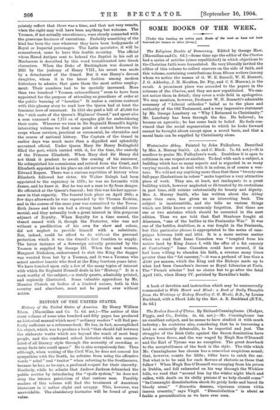C URRENT LITERATURE.
THE YEOMEN OF THE GUARD.
The History of the Yeomen of the Guard. By Colonel Sir Reginald Hennell, D.S.O. (A. Constable and CO. .£3 3s. net.)— It is not for common folk to have the privilege of seeing the Yeomen of the Guard, or, to give them their full title, "The King's Bodyguard of the Yeomen of the Guard." (The 8011:10" what obscure Latin equivalent is Vallecti Garde Domini Regis.) Visitors to the Tower of London see splendidly accoutred beings who closely resemble the Yeomen,—indeed, they wear precisely the same uniform, excepting the crossbelt. But they are not the same ; their duties lie wholly within the precincts of the Tower. The real Yeomen of the Guard are seen only by those who dwell in, or have access to, Kings' houses. They are present at great State ceremonials, drawing-rooms, levees, and Royal balls. The best chance for an outsider to catch a glimpse of them is probably when they discharge the duty of searching the underground regions of the Houses of Parliament before the beginning of a Session. This, of course, is a reminiscence of Gunpowder Plot. The search is now naturally a form. The crypt of the Houses is brilliantly lighted by the electric light, and the little oil lamps which the Yeomen still use do not contribute much to the illumination. The vaults of the old Houses were a very different place, and re- quired a real search. Those who have the privilege or the good fortune to see these picturesque survivals of the past may appro. priately reflect that there was a time, and that not very remote, when the sight may well have been anything but welcome. The Yeomen, if not actually executioners, were closely connected with the gruesome business of executions. Probably something of the kind has been the case wherever they have been bodyguards of Royal or Imperial personages. The Latin speculator, it will be remembered, came to have this double meaning. The official whom Herod Antipas sent to behead the Baptist in his cell at Machaerus is described by this word transliterated into Greek characters. When the Duke of Buckingham was doomed in 1521 by the jealousy of Henry VIII., his arrest was made by a detachment of the Guard. But it was Henry's devout daughter, whom it is the latest fashion among modern historians to admire, that gave them the most active employ- ment. Their numbers had to be specially increased. More than two hundred "Yeomen extraordinary" seem to have been appointed for the purpose of attending as guardians of order at the public burning of "heretics." It makes a curious contrast with this gloomy story to read how the Queen had at least the feminine love of ornament. In 1553 she paid a bill of .£1,000 for the "rich coats of the Queen's Highness' Guard," and spent also a sum unnamed on 7,175 oz. of spangles gilt for embroidering their coats. Wherever we turn in Sir Reginald Hennell's highly interesting volume we find some point of contact between the corps whose services, practical or ceremonial, he chronicles and the course of national history. The Captain of the Guard in earlier days was much more than a dignified and splendidly accoutred official. Under Queen Mary Sir Henry Bedingfield filled the post, which carried with it, for the time, the custody of the Princess Elizabeth. When Mary died Sir Henry did not think it prudent to await the coining of his successor. He relinquished his commission and retired from the Court, and Elizabeth appointed in his place an old servant of her father, Sir Edward Rogers. There was a curious repetition of history when Elizabeth followed her sister. Sir Walter Ralegh had been appointed to the captaincy in 1578; he was no favourite with James, and he knew it. But he was not a man to fly from danger. He officiated at the Queen's funeral ; but this was his last appear- ance in that capacity. The funeral took place on April 28th; a
few days afterwards he was superseded by Sir Thomas Erskine, and in the course of the same year was committed -to the Tower.
Both James and his son had a strong taste for splendid cere- monial, and they naturally took a great interest in this gorgeous adjunct of Royalty. When Royalty for a time ceased, the Guard ceased with it, though the Protector, who was not without a predilection of his own for show and colour, did not neglect to provide himself with a substitute.
Nor, indeed, could he afford to do without the personal protection which it was the Guard's first function to supply. The latest instance of a Sovereign actually protected by the Yeomen is supplied by George III. When the mad woman, Margaret Nicholson, endeavoured to stab the King the dagger was wrested from her by a Yeoman, and it was a Yeoman who seized another lunatic who fired at the King fourteen years later.
We have touched upon only a few of the many topics of interest with which Sir Reginald Hennell deals in his "History." It is a
work worthy of the subject,—a stately quarto, admirably printed, and copiously illustrated. Some valuable appendices by Mr. Maurice Church on bodies of a kindred nature, both in this country and elsewhere, must not be passed over without notice.



































 Previous page
Previous page